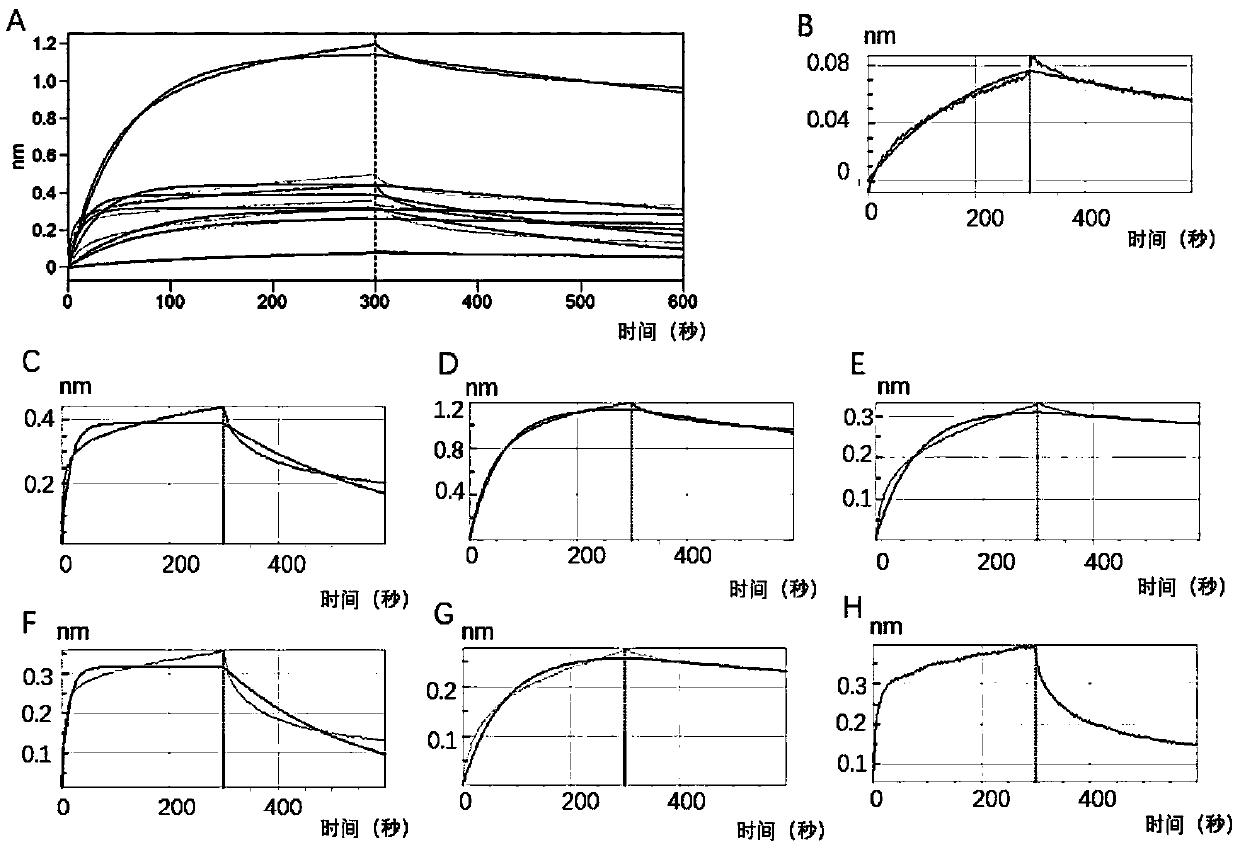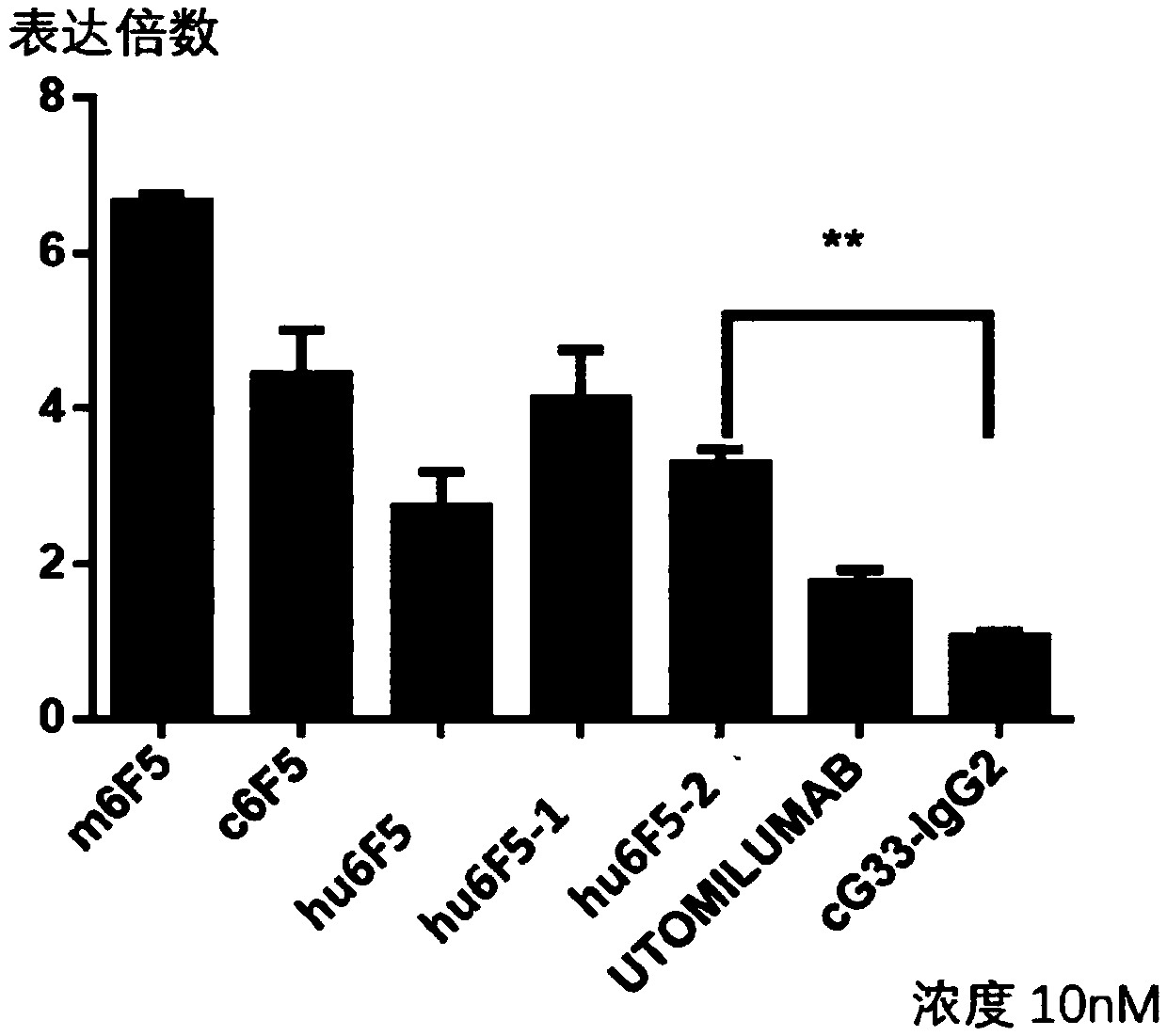CD137 antibody and application thereof
A CD137, antibody technology, applied in the field of biomedicine, can solve the problems of limited specific recognition and binding ability, limited ability of immune cells to secrete cytokines, limited ability to activate, etc.
- Summary
- Abstract
- Description
- Claims
- Application Information
AI Technical Summary
Problems solved by technology
Method used
Image
Examples
Embodiment approach
[0165] 1 antibody or antigen-binding fragment thereof in 1 x 10 -9 K below M D Values are combined with CD137 protein.
[0166] 2. The antibody or antigen-binding fragment thereof according to embodiment 1, whose titer when binding to CD137 protein is 1:10 4 or higher.
[0167] 3. The antibody or antigen-binding fragment thereof according to any one of embodiments 1-2, which competes with the CD137 ligand for binding to the CD137 protein.
[0168] 4. The antibody or antigen-binding fragment thereof according to any one of embodiments 1-3, which activates the NF-κB signaling pathway.
[0169] 5. The antibody or antigen-binding fragment thereof according to embodiment 4, wherein the activating the NF-κB signaling pathway comprises up-regulating the expression level of the NF-κB luciferase reporter gene.
[0170] 6. The antibody or antigen-binding fragment thereof according to any one of embodiments 1-5, which promotes PBMC cell proliferation.
[0171] 7. The antibody or a...
Embodiment 1
[0247] The preparation of embodiment 1 antibody
[0248] Mouse immunization: balb / c mice were immunized 5 times with Freund's adjuvant (sigma) mixed with 50 μg human CD137 extracellular domain protein (purchased from Beijing Yiqiao Shenzhou Science and Technology Co., Ltd.) via intraperitoneal (i.p.) and subcutaneous (s.c.) . Prior to fusion, mice were boosted intraperitoneally with the same amount of antigen. Serum titers (titers) of anti-human CD137 antibodies from splenocytes of immunized mice reached 10 5 , splenocytes from immunized mice were fused with mouse myeloma cells SP2 / 0 according to standard methods.
[0249] Hybridoma fusion: fusion of mouse spleen according to the existing conventional hybridoma fusion method, and HAT screening method to screen the fused hybridoma cells. The supernatant was taken and detected by ELISA with a human CD137-his-tag antigen-coated microtiter plate. Positive hybridoma clones were selected and expanded in 24-well plates and subclo...
Embodiment 2
[0251] Determination of Example 2 Antibody Sequence
[0252] Use TrizoI (purchased from Shanghai Sangong Bio) to extract the total RNA of the hybridoma cell line prepared in Example 1, use a reverse transcription kit (purchased from Takara Company) to reverse-transcribe the mRNA into cDNA, and use the cDNA as a template for PCR. The Ig-PrimerSets kit clones the antibody heavy chain and light chain variable region sequences respectively; the cloned antibody heavy chain and light chain variable region sequences are sequenced.
[0253] The antibodies sequenced were named c2H10, c3F3, c3F10, c20A11, c34F2, c9A7, c6F5 and c8G6, respectively. These monoclonal antibodies were constructed into chimeric antibodies: the heavy chain variable region and light chain variable region of each antibody were cloned into the heavy chain expression vector and the light chain expression vector respectively, and the heavy and light chain expression vectors of each chimeric antibody were cloned into...
PUM
| Property | Measurement | Unit |
|---|---|---|
| antibody titer | aaaaa | aaaaa |
Abstract
Description
Claims
Application Information
 Login to View More
Login to View More - R&D
- Intellectual Property
- Life Sciences
- Materials
- Tech Scout
- Unparalleled Data Quality
- Higher Quality Content
- 60% Fewer Hallucinations
Browse by: Latest US Patents, China's latest patents, Technical Efficacy Thesaurus, Application Domain, Technology Topic, Popular Technical Reports.
© 2025 PatSnap. All rights reserved.Legal|Privacy policy|Modern Slavery Act Transparency Statement|Sitemap|About US| Contact US: help@patsnap.com



